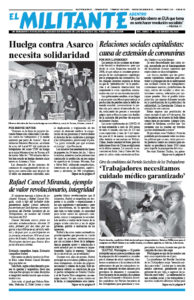The Russian and Turkish governments signed a tentative cease-fire deal March 5 after months of deadly clashes between the rival Syrian forces they back that are fighting for control of Idlib province. Similar “de-escalation” deals between the same powers have failed to overcome their differences and paved the way for new conflicts, with the toll falling on working people.
“We call it the killer cease-fire,” Abdulkafi, a teacher and supporter of the rebels’ nine-year fight against the dictatorial rule of Syrian President Bashar al-Assad, told the Financial Times March 8. “What’s coming after it is destruction.”
1 million people have fled Idlib
Since December 1 million people have fled their homes in Idlib after a scorched-earth offensive by Syrian forces, backed by Moscow’s air power and Tehran-organized militias. Many of those driven from their homes are living in makeshift camps near the Turkish border in freezing conditions, while others have fled to Idlib city, seeking shelter in bombed-out buildings there.
The Syrian government aims to capture the entire province, the last area of the country beyond government control with the exception of the area east of the Euphrates River held by U.S.-backed Kurdish forces.
“What’s the point of the cease-fire if people can’t return home?” farmer Abu Ali told Reuters after fleeing to a refugee camp in northwestern Syria earlier this year. The province has long been the last holdout of different opposition groups that took up arms and seized territory across Syria in response to Assad’s brutal suppression of a popular uprising for political rights in 2011. In the course of the civil war that followed, the Turkish government armed some of Assad’s opponents, including the Free Syrian Army. The price for that support was their agreement to join the Turkish rulers’ invasion of Afrin, a Kurdish-held area in northwest Syria.
Turkish President Recep Tayyip Erdogan is determined to push back the autonomous areas Syrian Kurds have secured control over. Some 30 million Kurds, divided across Iran, Iraq, Syria and Turkey, have fought against government assaults on their struggle for national sovereignty for decades.
The deal between the Russian and Turkish governments registers territorial gains made by the Assad regime and Moscow since December, including control of the M5 highway connecting Aleppo, Syria’s second-largest city, and Damascus, the capital.
“Even if he [Assad] goes, someone will replace him,” Abdullah Mohammad told Al Jazeera after fleeing from Saraqeb last month. “For decades our issue has been the tight fist of [Syrian] security.”
Erdogan says his forces have no intention of abandoning the observation posts they control in the province. Moscow has used its alliance with Assad to secure its air force and naval bases in Syria. Both governments, as well as Tehran, which deploys sizable forces in Syria, do so to advance their own economic and political interests.
The capitalist rulers in the U.S. maintain far and away the largest armada of air, naval and ground forces in the region. Washington refused to provide the Turkish government, its NATO “ally,” with either air support or the missile defense systems it requested to battle Assad’s forces. The U.S. government is trying to pressure the Turkish rulers to back off the closer relations they have forged with the rulers in Moscow.
Large parts of Idlib remain under control of the Islamist group Hayat Tahrir al-Sham (HTS). Syrian government forces continue to shell areas held by HTS since the cease-fire was signed.

